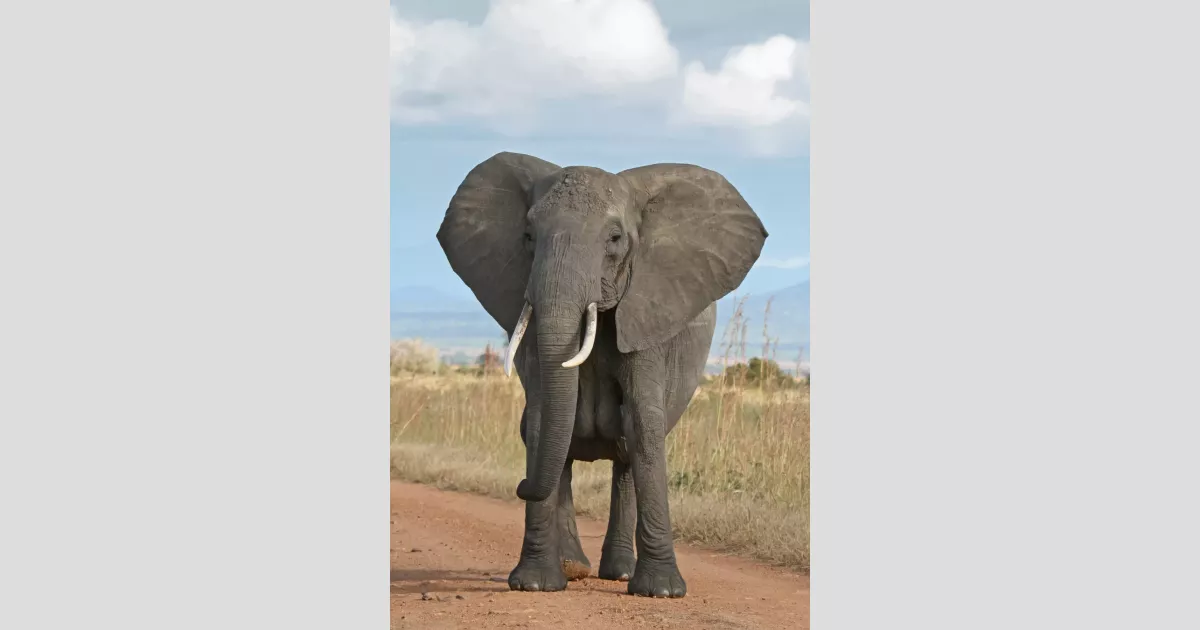Elephants are the largest land animals on Earth, with three recognized species: African bush elephants, African forest elephants, and Asian elephants. These gentle giants are distinguished by their trunks (elongated noses used for various tasks), tusks (modified teeth), large ear flaps for temperature regulation and communication, and pillar-like legs. While African elephants possess larger ears and concave backs, Asian elephants have smaller ears and convex or level backs. As the last surviving members of the Elephantidae family, elephants share ancestry with extinct creatures like mammoths and mastodons.
1950: Introduction of Tranquilizers for Elephant Capture
The year 1950 marked a shift in elephant capture methods with the introduction of tranquilizers. This new technique, replacing traditional methods like traps and lassos, aimed to make the process less stressful for the animals and safer for handlers.
1960: Enactment of India's Prevention of Cruelty to Animals Act
In 1960, India took a significant step in animal welfare with the enactment of The Prevention of Cruelty to Animals Act. This legislation provided legal protection for captive elephants, including those employed in various industries, aiming to prevent abuse and ensure their humane treatment.
1975: CITES Appendix I Listing for Asian Elephants Impact on Imports
After CITES listed Asian elephants under Appendix I in 1975, imports of the species had almost entirely ceased by the late 1980s.
1977: Start of Elephant Population Decline in East Africa
In 1977, a concerning trend in elephant populations began to emerge in East Africa, marking the start of a period of significant decline.
1979: High Estimate of African Elephant Population
In 1979, estimations suggested a sizable African elephant population, ranging from at least 1.3 million to potentially as high as 3 million.
1987: Debate on Elephant Emotion and the Oxford Companion's Stance
In 1987, the debate surrounding the extent to which elephants experience emotions was ongoing. Scientists observed that elephants are drawn to the remains of their own kind, even those outside their family groups. The death or distress of an elephant often triggers attention and support from others, sometimes from different groups. While some interpreted this as a sign of "concern," the Oxford Companion to Animal Behaviour recommended focusing on observable actions rather than trying to determine underlying emotions.
June 1989: United States Initiates Ban on Ivory Imports
In a landmark move against the ivory trade, the United States took a decisive step in June 1989 by imposing a ban on ivory imports. This action marked a turning point in international efforts to combat elephant poaching and protect dwindling elephant populations, setting a precedent for other countries to follow.
1989: Significant Decline of Elephant Populations in East Africa
By 1989, a decade after initial estimates, East Africa's elephant populations had experienced a substantial decline, plummeting by 74%.
1989: CITES Appendix I Listing for African Elephants
In a significant move for the protection of African elephants, the Convention on International Trade in Endangered Species of Wild Fauna and Flora (CITES) included the species under Appendix I in 1989. This listing effectively rendered the trade of African elephants and their products illegal, aiming to curb the devastating impacts of poaching and illegal wildlife trade.
1990: CITES Enacts International Ivory Ban
In a significant victory for elephant conservation, the Convention on International Trade in Endangered Species of Wild Fauna and Flora (CITES) implemented a global ban on ivory trade in 1990. This landmark decision aimed to curb the rampant poaching of elephants for their ivory, which had reached alarming levels.
1997: CITES Appendix II Listing for Elephants in Select Southern African Countries
In 1997, CITES granted Appendix II status to elephants in Botswana, Namibia, and Zimbabwe. This designation allowed for restricted trade in elephant products from these countries, recognizing their relatively healthier elephant populations and conservation efforts.
2000: Estimated Number of Working Elephants in Asia
In 2000, there were an estimated 13,000 to 16,500 working elephants employed across Asia.
2000: CITES Appendix II Listing for Elephants in South Africa
South Africa joined the ranks of Botswana, Namibia, and Zimbabwe in 2000 when CITES granted its elephant populations Appendix II status, permitting restricted trade in elephant products under specific regulations.
2000: Start of Escalating Human-Elephant Conflicts in India
The year 2000 marked the beginning of a concerning period of increased human-elephant conflicts in India, with a significant rise in elephant attacks on villages, leading to numerous human fatalities.
2001: Elephant Attacks Plague Assam, India
Between 2001 and 2006, the state of Assam in India faced a severe surge in elephant attacks, resulting in the reported deaths of 239 people, highlighting the growing conflict between humans and elephants.
December 2002: Allegations of Drunk Elephants Rampaging in Indian Village
In a bizarre and tragic incident in December 2002, a group of elephants, allegedly intoxicated, attacked a village in India, resulting in the death of six people. This led to a wave of retaliatory killings by locals, resulting in the death of around 200 elephants.
2004: Human-Elephant Conflicts Continue to Claim Lives in India
The human-elephant conflict in India continued to escalate, with reports stating that 300 people lost their lives in Jharkhand between 2000 and 2004 due to elephant attacks.
2006: End of a Deadly Period for Human-Elephant Conflicts in Assam
By 2006, the wave of elephant attacks that had plagued Assam, India, for five years seemed to subside, but the underlying tension between humans and elephants remained a pressing issue.
2008: Local Elephant Population Management Through Contraception and Translocation
By 2008, more controlled approaches to elephant management were adopted in certain regions. This included measures such as contraception and translocation to regulate local elephant numbers and mitigate potential conflicts with human activities.
2009: Circus Cruelty Exposed in US Federal Court
The use of harsh training methods on circus elephants, including the use of bull hooks and electric prods, was brought to light during a US federal court case in 2009, sparking controversy and raising concerns about animal welfare.
February 2012: Bouba Njida National Park Elephant Massacre
In a devastating blow to elephant conservation efforts, February 2012 witnessed a horrific massacre in Cameroon's Bouba Njida National Park. An estimated 650 elephants were slaughtered by heavily armed poachers from Chad, marking one of the most gruesome mass killings of elephants since the international ivory ban.
May 2015: China's Announcement to Phase Out Domestic Ivory Trade
In a significant step toward combating the illegal ivory trade, China, a major consumer of ivory, announced in May 2015 its commitment to phase out the legal domestic manufacture and sale of ivory products. This decision signaled a potential turning point in reducing demand and curbing the devastating impact of poaching on elephant populations.
September 2015: China and the United States Jointly Announce Near-Total Ivory Trade Ban
In a historic move to combat elephant poaching and protect these majestic animals from extinction, China and the United States joined forces in September 2015 to announce a near-total ban on the import and export of ivory.
May 2016: Barnum and Bailey Circus Retires Touring Elephants
In a significant move for animal welfare, the Barnum and Bailey circus made the decision to retire its touring elephants in May 2016, marking the end of an era.
2016: IUCN Estimated Total Elephant Population in Africa
In 2016, the IUCN estimated the total elephant population in Africa to be around 415,000 individuals, combining both forest and bush elephant species.
2019: Surge in Elephant-Related Deaths in India
Tragically, between 2019 and 2022, India witnessed an alarming surge in human deaths attributed to elephant attacks, with a staggering figure of 1,500 fatalities recorded, further intensifying the human-elephant conflict.
2020: IUCN Endangered Listing for Asian Elephants
The International Union for Conservation of Nature (IUCN) listed Asian elephants as an endangered species in 2020. This decision stemmed from a concerning population decline of over 50% within the preceding three generations, highlighting the growing threats to their survival.
2021: IUCN Endangered and Critically Endangered Listings for African Elephants
In a significant conservation development in 2021, the International Union for Conservation of Nature (IUCN) designated African bush elephants as Endangered and African forest elephants as Critically Endangered, highlighting the urgent need for increased protection measures for both species.
2022: Escalating Human-Elephant Conflict Leads to Retaliatory Killings
The escalating human-elephant conflict in India reached a grim milestone as 1,500 people were killed by elephants between 2019 and 2022. This led to a disturbing counter-reaction, with 300 elephants killed in acts of retaliation, highlighting the tragic cycle of violence.
Mentioned in this timeline
India officially the Republic of India is a South Asian...
Africa is the second-largest and second-most populous continent comprising of...
China officially the People's Republic of China PRC is an...
South Africa officially the Republic of South Africa RSA is...
Cameroon officially the Republic of Cameroon is a Central African...
Somalia officially the Federal Republic of Somalia is located in...
Trending

9 months ago Keith Urban Discusses Love Songs, Vocal Surgery Impact, and Musical Experimentation

4 months ago Kevin O'Leary on Success, Steve Jobs, and Prenups: Key Insights Revealed

1 month ago Bradley Cooper directs Will Arnett and Laura Dern in the dramedy 'Is This Thing On?'

9 months ago Bucks Defeat Kings: Giannis' Dominance and Keegan Murray's Performance in a Tense Match
7 months ago JuJu Watkins Recruiting Impact: Byles Visits USC, Watkins' GOAT Choice Revealed.

2 months ago Ben Stiller Opens Up About Feeling Like a Failure During Separation From Wife
Popular

Candace Owens is an American conservative political commentator and author...

Tucker Carlson is an American conservative political commentator known for...

XXXTentacion born Jahseh Dwayne Ricardo Onfroy was a controversial yet...

Ben Shapiro is a prominent American conservative political commentator media...

William Franklin Graham III commonly known as Franklin Graham is...

Bill Gates an American businessman and philanthropist revolutionized personal computing...
